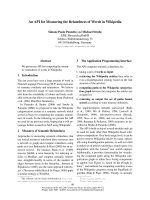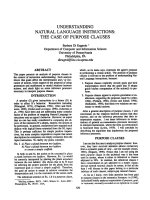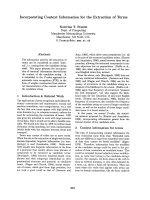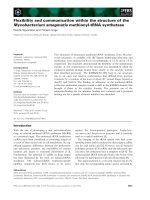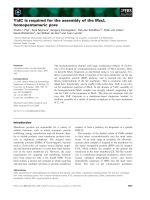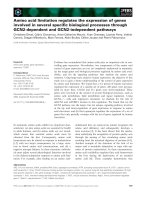Báo cáo khoa học: "Endogenous angiotensin II in the regulation of hypoxic pulmonary vasoconstriction in anaesthetized dog" ppt
Bạn đang xem bản rút gọn của tài liệu. Xem và tải ngay bản đầy đủ của tài liệu tại đây (184.7 KB, 9 trang )
Open Access
Available online />R163
August 2004 Vol 8 No 4
Research
Endogenous angiotensin II in the regulation of hypoxic pulmonary
vasoconstriction in anaesthetized dogs
Ives Hubloue
1
, Benoît Rondelet
2
, François Kerbaul
2
, Dominique Biarent
2
, Guiti Malekzadeh Milani
2
,
Michel Staroukine
3
, Pierre Bergmann
3
, Robert Naeije
2
and Marc Leeman
2
1
Department of Intensive Care Medicine, Akademisch Ziekenhuis VUB, and Laboratory of Physiology, Faculty of Medicine, Erasme Campus of the
Free University of Brussels, Brussels, Belgium
2
Laboratory of Physiology, Faculty of Medicine, Erasme Campus of the Free University of Brussels, Brussels, Belgium
3
Laboratory of Radioimmunology and Experimental Medicine, Brugmann Hospital, Brussels, Belgium
Corresponding author: Ives Hubloue,
Abstract
Introduction The role played by several vasoactive mediators that are synthesized and released by the
pulmonary vascular endothelium in the regulation of hypoxic pulmonary vasoconstriction (HPV) remains
unclear. As a potent vasoconstrictor, angiotensin II could be involved. We tested the hypothesis that
angiotensin-converting enzyme inhibition by enalaprilat and type 1 angiotensin II receptor blockade by
candesartan would inhibit HPV.
Methods HPV was evaluated in anaesthetized dogs, with an intact pulmonary circulation, by examining
the increase in the Ppa–Ppao gradient (mean pulmonary artery pressure minus occluded pulmonary
artery pressure) that occurred in response to hypoxia (inspiratory oxygen fraction of 0.1) at constant
pulmonary blood flow. Plasma renin activity and angiotensin II immunoreactivity were measured to
determine whether activation or inhibition of the renin–angiotensin system was present.
Results Administration of enalaprilat and candesartan did not affect the Ppa–Ppao gradient at baseline
or during hypoxia. Plasma renin activity and angiotensin II immunoreactivity increased during hypoxia,
and subsequent measurements were consistent with effective angiotensin-converting enzyme
inhibition after administration of enalaprilat, and with angiotensin receptor blockade after administration
of candesartan.
Conclusion These results suggest that, although the renin–angiotensin system was activated in
hypoxia, angiotensin II is not normally involved in mediating acute HPV.
Keywords: angiotensin II, angiotensin-converting enzyme inhibition, angiotensin receptor antagonism, hypoxic pul-
monary vasoconstriction, renin–angiotensin system
Introduction
Hypoxic pulmonary vasoconstriction (HPV) is a physiological
response mechanism in the lung whereby circulating blood is
driven away from hypoxic alveoli in order to optimize the
matching of perfusion and ventilation and to maximize arterial
oxygenation [1,2]. Because it is unique and perhaps the most
powerful active control mechanism in the pulmonary circula-
tion, HPV has been an area of intensive investigation and
debate since it was first described by von Euler and Liljestrand
in 1947 [3]. This physiological hypoxic response mechanism
has been found in all mammalian species but it varies in
expression from one species to another, from absent (in rab-
bits and guinea pigs), through moderate (in humans and
dogs), to vigourous (in cattle and cats) [1,2,4]. The presence
Received: 28 November 2003
Revisions requested: 22 January 2004
Revisions received: 26 March 2004
Accepted: 7 April 2004
Published: 14 May 2004
Critical Care 2004, 8:R163-R171 (DOI 10.1186/cc2860)
This article is online at: />© 2004 Hubloue et al.; licensee BioMed Central Ltd. This is an Open
Access article: verbatim copying and redistribution of this article are
permitted in all media for any purpose, provided this notice is preserved
along with the article's original URL.
ACE = angiotensin-converting enzyme; AT
1
= type 1 angiotensin II receptor; AT
2
= type 2 angiotensin II receptor; FiO
2
= fractional inspired oxygen;
HPV = hypoxic pulmonary vasoconstriction; Ppa = mean pulmonary artery pressure; Ppao = occluded pulmonary artery pressure; Psa = systemic
artery pressure; PVR = pulmonary vascular resistance; Q = cardiac output.
Critical Care August 2004 Vol 8 No 4 Hubloue et al.
R164
of HPV in critically ill mechanically ventilated patients can be
observed in routine clinical practice because these patients
present with acute pulmonary hypertension if artificial ventila-
tion is accidentally interrupted, and with severe hypoxaemia if
drugs are administered that inhibit HPV [2]. As a potent vaso-
constrictor and growth promotor, angiotensin II could play a
role in HPV and pulmonary vascular remodelling [4,5]. There
exists a variety of conflicting data concerning the possible role
of angiotensin II in HPV. Some studies showed that inhibition
of the renin–angiotensin cascade, by means of angiotensin-
converting enzyme (ACE) inhibition [6-10] or angiotensin II
receptor blockade [9,11-14], reduces pulmonary vascular
tone in normoxia [6,7] and hypoxia [8-14]. However, other
studies did not confirm the pulmonary vasodilating effect of an
ACE inhibitor [15,16] and of an angiotensin II receptor antag-
onist [17,18]. This controversy in the reported data can be
explained in part by an important variability in hypoxic response
between the different species in these studies and by differ-
ences in the experimental models employed (acute versus
chronic HPV, in vivo versus in vitro).
In the context of previous experiments from our laboratory,
studying the possible role of endothelial mediators (endothe-
lins, nitric oxide and thromboxane A
2
) in the same anaesthe-
tized dog model [19-21], we studied the effects of
endogenous angiotensin II on pulmonary vascular tone in con-
ditions of increased fractional inspired oxygen (FiO
2
; 0.4) and
hypoxia. This model may reflect the clinical condition of
mechanically ventilated patients, and the canine pulmonary
vascular response to hypoxia is considered to be a good
model of human HPV [2,4]. Furthermore, we evaluated the
functional status of the pulmonary vascular system by measur-
ing pulmonary vascular pressures at constant cardiac output
(Q) in order to avoid flow-dependent changes in mediator
release and in pulmonary vascular pressures [19-21].
In accordance with previously reported data [8-10], we started
from the hypothesis that the ACE inhibitor enalaprilat would
inhibit HPV. Whether this pulmonary haemodynamic effect
could be a consequence of reduced angiotensin II levels is
unknown because ACE inhibition increases bradykinin levels
[22], which may dilate pulmonary vessels [23]. We therefore
performed the same experiments using the type 1 angiotensin
II receptor (AT
1
) antagonist candesartan, which to our knowl-
edge has never been used in this setting – in order to avoid
possible effects of bradykinin resulting from ACE inhibition
and to provide a more robust interpretation of the possible role
played by angiotensin II in HPV. Few studies have been
reported on the effects of both drugs on the renin–angiotensin
system in this model [9]. Results from these experiments could
influence the choice of whether to use or avoid ACE inhibitors
and/or angiotensin II receptor antagonists in critically ill
patients in certain conditions.
Methods
The experiments were conducted in agreement with the Guide
for the Care and Use of Laboratory Animals of the US National
Institutes of Health, and were approved by the Committee on
the Care and Use of Animals in Research of the Brussels Free
University School of Medicine, Brussels, Belgium.
Animal preparation
Sixteen mongrel dogs (16–38 kg) were anaesthetized with
pentobarbital sodium (25 mg/kg intravenously), paralyzed with
pancuronium bromide (0.2 mg/kg intravenously), intubated
and ventilated (Elema 900 B Servo ventilator; Siemens, Sölna,
Sweden) with a tidal volume of 15–20 ml/kg (adjusted to
maintain arterial partial CO
2
tension between 35 and 45
mmHg), a respiratory rate of 12 breaths/min and a FiO
2
of 0.4.
This higher than normal FiO
2
was selected to maintain the
lungs above the threshold for HPV [19-21]. Anaesthesia and
lack of pain sensation were assessed before muscular paraly-
sis was induced; they were judged to be complete if there
were no movements or haemodynamic changes (heart rate,
systemic arterial pressure) during insertion of the catheters.
Pentobarbital (2 mg/kg intravenously) was repeated hourly to
maintain anaesthesia. Pancuronium (0.2 mg/kg intravenously)
was repeated before each haemodynamic measurement. Fem-
oral and pulmonary artery catheters were inserted for meas-
urements of systemic and pulmonary vascular pressures, and
Q, and for sampling of arterial and mixed venous blood. A bal-
loon catheter was advanced in the inferior vena cava through
a right femoral venotomy, and a large bore cannula was
inserted into the left femoral artery and vein to act as an arteri-
ovenous bypass. Stepwise inflations of the balloon catheter or
opening of the bypass decreased or increased Q [19-21]. A
left jugular catheter was placed for fluid and drug administra-
tion. Thrombus formation along the catheters was prevented
by administration of heparin (100 U/kg intravenously).
Measurements
Vascular pressures were recorded and measured at end-expi-
ration and at constant Q. Heart rate was determined from a
continuously monitored electrocardiographic lead. Q was
measured by thermodilution. Arterial and mixed venous blood
gases were measured immediately after drawing the samples
using a tonometered automated analyzer (ABL2; Radiometer,
Copenhagen, Denmark) and corrected for temperature. When
excessive metabolic acidosis occurred, it was corrected by a
slow infusion of sodium bicarbonate. Temperature was kept
constant using an electric heating blanket.
Plasma renin activity and angiotensin II immunoreactivity were
measured in arterial and mixed venous blood at baseline, and
after ACE inhibition and after angiotensin II receptor blockade
during increased inspired oxygen (FiO
2
0.4) and hypoxia. Sam-
ples of 10 ml arterial and mixed venous blood were simultane-
ously and directly withdrawn into polysterene tubes containing
disodium salt of ethylenediaminetetraacetic acid (4.64 mg/ml)
Available online />R165
and 1–10 phenantroline (0.5 mg/ml), which act as inhibitors of
ACE and angiotensinase. Tubes containing blood were imme-
diately centrifuged at 3000 g for 10 min. Supernatants were
frozen at -20°C until they were assayed.
Plasma renin activity was measured from the generation rate
of angiotensin I at 37°C and pH 6. A set of samples kept at
0°C during the same period served as a control. Angiotensin I
was quantified by direct radioimmunoassay using rabbit anti-
angiotensin I antiserum and
125
I-labelled angiotensin I pro-
duced according to the method of Waite [24]. Cross-reactivity
of the antiserum with angiotensin II was under 0.1%. The intra-
assay variation was 11%, and the interassay variation was
10%.
Plasma angiotensin II immunoreactivity was measured by the
method of Düsterdieck [25]. Briefly, each sample was
extracted by using Dowex H
+
ion exchange resin. After wash-
ing with water, peptides were eluted from the column with 2
ml of a solution of ammonia–methanol (90:10, vol:vol). The
extracts were dried and redissolved in 50 mmol/l Tris buffer
(pH 7.5) for radioimmunoassay with
125
I-labelled angiotensin II
and a rabbit anti-angiotensin II antiserum. Cross-reactivity of
the antiserum with angiotensin I was 0.4%. The intra-assay
and interassay variations with repeated extractions were 17%
and 13%, respectively.
Effects of enalaprilat
First the dogs (n = 10) were subjected to two hypoxic chal-
lenges, consisting of a decrease in FiO
2
from 0.4 to 0.1 for 6
min to allow stabilization. They then received 1 mg/kg enalapri-
lat (Merck & Co. Inc., Whitehouse Station New Jersey, USA;
intravenously) and two additional hypoxic challenges were
performed thereafter. This dose of enalaprilat results in maxi-
mal ACE inhibition in dogs [26]. It is also known that maximal
blockade of angiotensin II pressor response is achieved with
0.25 mg/kg enalaprilat [27]. In these experiments enalaprilat
was given as an intravenous bolus of 0.5 mg/kg followed by a
constant infusion of 0.5 mg/kg. The infusion rate was adjusted
so that at the end of the experiments all dogs received the total
dose. We additionally checked the effectiveness of this dos-
age regimen in pilot experiments conducted in three dogs
receiving an intravenous bolus of 0.25, 0.50 and 1 mg/kg
-1
(data not shown). Q was kept constant by opening the femoral
bypass or by inflating the inferior vena caval balloon. In each
experimental condition mean pulmonary artery pressure (Ppa),
occluded pulmonary artery pressure (Ppao), systemic artery
pressure (Psa) and Q were recorded, and blood was drawn
after 3 min of steady state, as assessed by stability of contin-
uously monitored Psa, Ppa and heart rate [19-21].
Effects of candesartan
A similar series of experiments were conducted with cande-
sartan (AstraZeneca, Mölndal, Sweden). Recommendations
from the AstraZeneca Research Department for preparation
and dosing of an intravenous solution of candesartan were fol-
lowed. Candesartan is slightly soluble in water or physiological
saline, but it is completely soluble in a 1 N Na
2
CO
3
solution.
The neutrality of this vehicle was assessed in three anaesthe-
tized dogs, in which no effects on Ppa, Psa and Q were
observed either in the absence or presence of increased
inspired oxygen or hypoxia (data not shown).
The recommended dose for effective AT
1
receptor blockade in
dogs of 1 mg/kg produced a 17% decrease in mean Psa,
which is comparable with the change observed after adminis-
tration of enalaprilat. In addition, elevations in plasma renin
activity and in immunoreactive angiotensin II after candesartan
administration were consistent with AT
1
receptor antagonism.
In the experiments candesartan was given as an intravenous
bolus of 0.5 mg/kg followed by a constant infusion of 0.5 mg/
kg. The infusion rate was adjusted so that at the end of the
experiments all dogs received the total dose. We also checked
the effectiveness of this dosage regimen in three pilot experi-
ments in dogs receiving an intravenous bolus of 0.25, 0.50
and 1 mg/kg candesartan. Evidence for maximal AT
1
receptor
blockade (also measured by means of systemic hypotension
and generation of plasma renin activity and angiotensin II
immunoreactivity) occurred at a dose of 0.5 mg/kg (data not
shown).
Analysis of the data
Results are expressed as means ± standard error of the mean.
Body surface area (m
2
) was calculated as 0.112 × weight
(kg)
2/3
. A two-factor analysis of variance for multiple measure-
ments was used to assess the effects of both medications on
haemodynamics. When the F ratio of the analysis of variance
reached P < 0.05, modified Student's t-tests were used to
determine which means differed [28].
Results
Effects of enalaprilat
Haemodynamic data
Enalaprilat decreased mean Psa by 15% during FiO
2
0.4
(Table 1). Hypoxia increased the Ppa–Ppao gradient (i.e.
mean Ppa minus Ppao) measured at constant Q (Fig. 1a).
Enalaprilat did not affect Ppa–Ppao gradient in the presence
of increased FiO
2
or in hypoxia (Fig. 1a) and had no effect on
hypoxic response (Fig. 1b).
Plasma renin activity and angiotensin II immunoreactivity
Plasma renin activity increased in the systemic as well as in the
pulmonary circulation during hypoxia and after enalaprilat dur-
ing FiO
2
0.4 (Fig. 2a). Angiotensin II immunoreactivity
increased during hypoxia in the systemic and pulmonary circu-
lations before enalaprilat administration, but it was not detect-
able after enalaprilat administration (Fig. 2b).
Critical Care August 2004 Vol 8 No 4 Hubloue et al.
R166
Effects of candesartan
Haemodynamic data
There was a 17% decrease of mean Psa during FiO
2
0.4 after
candesartan administration (Table 2). There was an increase
in Ppa–Ppao gradient after hypoxia (Fig. 3a). Ppa–Ppao gradi-
ent was not influenced after candesartan during increased
FiO
2
or in hypoxia (Fig. 3a). Hypoxic response was not influ-
enced after candesartan (Fig. 3b).
Plasma renin activity and angiotensin II immunoreactivity
Plasma renin activity and angiotensin II immunoreactivity
increased in the systemic and pulmonary circulations during
hypoxia and after candesartan during FiO
2
0.4 (Fig. 4).
Discussion
The present results show that, in anaesthetized dogs, ACE
inhibition or AT
1
receptor blockade did not affect pulmonary
vascular tone during increased FiO
2
or in hypoxia, although
measurements of plasma renin activity and angiotensin II
immunoreactivity suggested activation of the rennin-angi-
otensin system during hypoxia and effective blockade of the
renin-angiotensin cascade with enalaprilat and candesartan.
These data do not support a role for endogenous angiotensin
II in acute HPV in intact dogs.
Pulmonary vascular resistance (PVR) in intact animals and in
humans is commonly evaluated by the calculation of Ppa
minus Ppao divided by Q. This method is based on the
assumptions that the Ppa–Ppao/Q relationship is linear and
passes through the origin. The latter is in fact incorrect when
the lungs are diseased and/or hypoxic [19-21]. When the
extrapolated pressure intercept of the Ppa/Q plots (i.e. the
closing pressure of the pulmonary vessels or their effective
downstream pressure) exceeds Ppao, the calculation of PVR
cannot discriminate between passive (flow dependent) and
active changes in Ppa. We should like to stress that, as in pre-
vious experiments, we took great care to maintain Q constant
in the present study. When Q is kept constant, PVR is directly
proportional to the Ppa–Ppao gradient [19-21]. In contrast, in
the large series of published studies on angiotensin II in HPV,
this methodology was used only by Murray and coworkers
[6,7]. Whether angiotensin II is a mediator of HPV is contro-
versial. Berkov [29] found that angiotensin II was the only
mediator involved in HPV in isolated rat lungs, whereas
McMurtry [30] showed in the same model that angiotensin II
was not required for HPV. Furthermore, the renin–angiotensin
system has been shown to be activated [31,32], unaltered
[10,13], and depressed [18] during hypoxia. Finally, inhibition
of the renin–angiotensin cascade inhibited HPV in some
[8,10,13] but not all [15,17,18] studies.
As mentioned in the Introduction section (see above), part of
the controversial variety in the reported data concerning the
possible role of angiotensin II in HPV can be accounted for by
the important variability in hypoxic response between the stud-
ied species (mice, rat, cat, dog and human) [1,2,4]. There also
exists a large variety in the experimental models used to study
the pulmonary vasoreactive response. The experimental model
itself is a key factor in interpreting findings: intact animals are
different from isolated organs and more so from isolated ves-
sels. In this regard, additional weight is given to our data
because of the use of the intact dog model, which reflects in a
realistic manner the hypoxic pulmonary vascular response in
humans [2,4]
Our findings clearly show that neither ACE inhibition nor AT
1
receptor antagonism attenuated HPV, which is in accordance
with previous studies using captopril [15], saralasin [17] and
Table 1
Effects of enalaprilat in 10 dogs
Parameter Baseline Enalaprilat
FiO
2
0.4 0.1 0.4 0.1
Q (l/min per m
2
) 3.4 ± 0.1 3.5 ± 0.2 3.5 ± 0.1 3.4 ± 0.1
Ppa (mmHg) 14 ± 1 24 ± 2* 15 ± 2 28 ± 2*
†
Ppao (mmHg) 6 ± 1 5 ± 1 5 ± 1 6 ± 1
Psa (mmHg) 119 ± 4 123 ± 8 101 ± 3
†
102 ± 10
†
HR (beats/min) 169 ± 6 189 ± 8* 166 ± 5 183 ± 8*
pHa 7.34 ± 0.01 7.37 ± 0.01 7.34 ± 0.01 7.36 ± 0.02
PaO
2
(mmHg [kPa]) 172 ± 15 (23 ± 2) 30 ± 2* (4 ± 0.3) 168 ± 12 (22 ± 2) 29 ± 1* (4 ± 0.1)
PaCO
2
(mmHg [kPa]) 38 ± 1 (5 ± 0.1) 37 ± 1 (5 ± 0.1) 37 ± 1 (5 ± 0.1) 37 ± 1 (5 ± 0.1)
PvO
2
(mmHg [kPa]) 50 ± 2 (7 ± 0.1) 20 ± 2* (3 ± 0.3) 50 ± 2 (7 ± 0.3) 19 ± 2* (3 ± 0.3)
Data are presented as mean ± standard error of the mean. FiO
2
, fraction of inspired oxygen; HR, heart rate; PaCO
2
, carbon dioxide tension in
arterial blood; PaO
2
, oxygen tension in arterial blood; pHa, arterial pH; Ppa, mean pulmonary artery pressure; Ppao, pulmonary artery occluded
pressure; Pra, right atrial pressure; Psa, mean systemic artery pressure; PvO
2
, oxygen tension in mixed venous blood; Q, cardiac index. *P < 0.01
versus FiO
2
0.4, same drug condition;
†
P < 0.01 versus baseline, same FiO
2
.
Available online />R167
Figure 1
(a) Transpulmonary pressure gradient in the enalaprilat group(a) Transpulmonary pressure gradient in the enalaprilat group. Mean pulmonary artery pressure (Ppa) minus occluded pulmonary artery pressure
(Ppao) at constant cardiac output in 10 dogs as the fractional inspired oxygen (FiO
2
) was decreased from 0.4 to 0.1, before (base) and after admin-
istration of enalaprilat. (b) Hypoxic response in the enalaprilat group. Hypoxic response defined as the increase in the gradient between Ppa and
Ppao measured at constant cardiac output in response to a reduction in FiO
2
from 0.4 to 0.1 at baseline (base) and after administration of enalaprilat
in 10 dogs. In both panels the vertical bars indicate the standard error of the mean.
Figure 2
(a) Plasma renin activity (PRA) in the enalaprilat group(a) Plasma renin activity (PRA) in the enalaprilat group. PRA in mixed venous (white columns) and arterial (gray columns) blood during fractional
inspired oxygen (FiO
2
) 0.4 and during FiO
2
0.1 before (base) and after administration of enalaprilat in 10 dogs. (b) Angiotensin II immunoreactivity in
the enalaprilat group. Angiotensin II (ANG II) immunoreactivity in mixed venous (white columns) and arterial (gray columns) blood during FiO
2
0.4 and
during FiO
2
0.1 before (base) and after the administration of enalaprilat in 10 dogs. In both panels the vertical bars indicate the standard error of the
mean.
Critical Care August 2004 Vol 8 No 4 Hubloue et al.
R168
losartan [18] Of note, in the study conducted by Krebs and
coworkers [18] plasma renin activity and plasma angiotensin II
levels decreased during hypoxia in conscious dogs, which
suggests inhibition of the renin–angiotensin system by
hypoxia, and might explain the lack of effect of losartan on
HPV.
Why enalaprilat and candesartan did not affect HPV, despite
evidence of activation of the renin–angiotensin system during
hypoxia in our dogs, is not clear. A tentative explanation is that
hypoxia stimulates the release of pulmonary vasoconstrictors,
but that their effect is largely attenuated by the concomitant
release of vasodilators such as nitric oxide and prostacyclin
[19-21]. In support of this hypothesis, we recently showed that
the dual endothelin receptor antagonist bosentan did not
inhibit HPV in dogs, but that it did so after nitric oxide synthase
inhibition [21].
The absence of effect of enalaprilat and candesartan could be
due to an incomplete inhibition of the renin–angiotensin
system. We nevertheless believe that this system was effec-
tively blocked, as indicated by the expected changes in
plasma renin activity (increased after enalaprilat and cande-
sartan) and in angiotensin II immunoreactivity (abolished after
enalaprilat and increased after candesartan), and by the 15–
17% reduction in mean aortic pressure. In addition, the results
of the pilot experiments examining the dose–effect relationship
of both medications support maximal inhibition of the renin–
angiotensin cascade. Nyhan and coworkers [7], using pres-
sure–flow plots in normoxic conditions, showed that angi-
otensin II produced pulmonary vasoconstriction in conscious
as well as in dogs anaesthetized with pentobarbital. However,
the pulmonary vasodilator response to captopril observed in
conscious dogs was reversed to a paradoxical vasoconstric-
tion in pentobarbital anaesthetized dogs. In the present study
we cannot exclude that pentobarbital anaesthesia could have
altered the response of the pulmonary circulation to enalaprilat
and candesartan.
By constructing pulmonary vascular pressure–flow plots in the
same experimental preparation, we previously found that the
magnitude of hypoxia-induced increase in pulmonary vascular
pressures was unchanged after 2 hours of pentobarbital
anaesthesia [33].
Angiotensin II binds to AT
1
but also to AT
2
receptors. Absence
of pulmonary vascular effect of the AT
1
receptor blocker can-
desartan could be due to the action of angiotensin II on AT
2
receptors. Although pulmonary and systemic vascular beds
may respond differently to the same stimulus, it has been
shown in the systemic circulation that none of the established
cardiovascular effects of angiotensin II can be attributed to the
AT
2
receptor [34]. As a matter of fact, it is well recognized,
based on more recent data, that the haemodynamic effects of
angiotensin II are mediated via the AT
1
receptors [35]. Moreo-
ver, experimental data showed that the AT
1
receptor was the
predominant subtype in both normal and hypoxic lungs [11]
and that the pulmonary vasotonic response to angiotensin II
was mainly due the AT
1
subtype [36].
Conclusion
Obtained in anaesthetized dogs with intact pulmonary circula-
tion by measuring pulmonary vascular pressures at constant
flow, these data show that, although the renin–angiotensin
system seemed activated during hypoxia, ACE inhibition and
AT
1
receptor blockade did not attenuate HPV. This suggests
that angiotensin II does not play a role in mediating hypoxic
pulmonary vascular tone, at least when all counteracting
Table 2
Effects of candesartan in six dogs
Parameter Baseline Candesartan
FiO
2
0.4 0.1 0.4 0.1
Q (l/min per m
2
) 4.1 ± 0.1 4.3 ± 0.3 4.05 ± 0.1 4.4 ± 0.3
Ppa (mmHg) 12 ± 1 21 ± 1* 12 ± 1 22 ± 2*
Ppao (mmHg) 4 ± 1 3 ± 1 4 ± 1 3 ± 1
Psa (mmHg) 121 ± 3 126 ± 4 101 ± 2 + 116 ± 5
†
HR (beats/min) 123 ± 8 157 ± 8* 115 ± 6 + 145 ± 8*
pHa 7.39 ± 0.01 7.40 ± 0.01 7.38 ± 0.01 7.38 ± 0.01
PaO
2
(mmHg [kPa]) 271 ± 4 (36 ± 0.5) 31 ± 3* (4 ± 0.4) 254 ± 4 (34 ± 0.5) 27 ± 3* (3 ± 0.4)
PaCO
2
(mmHg [kPa]) 37 ± 1 (5 ± 0.1) 37 ± 1 (5 ± 0.1) 38 ± 1 (5 ± 0.1) 38 ± 1 (5 ± 0.1)
PvO
2
(mmHg [kPa]) 52 ± 1 (7 ± 0.1) 22 ± 2* (3 ± 0.3) 50 ± 2 (7 ± 0.3) 21 ± 1* (3 ± 0.1)
Data are presented as mean ± standard error of the mean. FiO
2
, fraction of inspired oxygen; HR, heart rate; PaCO
2
, carbon dioxide tension in
arterial blood; PaO
2
, oxygen tension in arterial blood; pHa, arterial pH; Ppa, mean pulmonary artery pressure; Ppao, pulmonary artery occluded
pressure; Pra, right atrial pressure; Psa, mean systemic artery pressure; PvO
2
, oxygen tension in mixed venous blood; Q, cardiac index. *P < 0.01
versus FiO
2
0.4, same drug condition;
†
P < 0.01 versus baseline, same FiO
2
.
Available online />R169
Figure 3
(a) Transpulmonary pressure gradient in the candesartan group(a) Transpulmonary pressure gradient in the candesartan group. Mean pulmonary artery pressure (Ppa) minus occluded Ppa (Ppao) at constant car-
diac output in six dogs as the fractional inspired oxygen (FiO
2
) was decreased from 0.4 to 0.1, before (base) and after administration of candesartan.
(b) Hypoxic response in the candesartan group. Hypoxic response defined as the increase in the gradient between Ppa and Ppao measured at con-
stant cardiac output in response to a reduction in FiO
2
from 0.4 to 0.1 at baseline (base) and after administration of candesartan in six dogs. In both
panels the vertical bars indicate the standard error of the mean.
Figure 4
(a) Plasma renin activity (PRA) in the candesartan group(a) Plasma renin activity (PRA) in the candesartan group. PRA in mixed venous (white columns) and arterial (gray columns) blood during fractional
inspired oxygen (FiO
2
) 0.4 and during FiO
2
0.1 before (base) and after administration of candesartan in six dogs. (b) Angiotensin II immunoreactivity
in the candesartan group. Angiotensin II (ANG II) immunoreactivity in mixed venous (white columns) and arterial (gray columns) blood during FiO
2
0.4 and during FiO
2
0.1 before (base) and after the administration of candesartan in six dogs. In both panels the vertical bars indicate the standard
error of the mean.
Critical Care August 2004 Vol 8 No 4 Hubloue et al.
R170
systems are intact. This conclusion is limited to acute hypoxia,
and so our findings do not exclude a role played by angi-
otensin II in chronic pulmonary hypertension and vascular
remodelling [8,11,36,37].
Apart from (patho)physiological interest in identifying different
mediators of HPV and pulmonary hypertension, results from
these experiments may have clinical implications because
enalaprilat and candesartan are available for use in humans.
Many patients admitted into the intensive care department (i.e.
after cardiac or vascular surgery) have mild hypoxaemia due to
basal atelectasis. If these patients must be treated with vasodi-
lating drugs, which are known to worsen pulmonary gas
exchange by inhibiting HPV [2], then ACE inhibitors or angi-
otensin II receptor blockers are a reasonable choice because
these drugs should not affect HPV and hence gas exchange.
Although we are not aware of a clinical study examining the
effects of these compounds on gas exchange, it has been
shown that nifedipine (a calcium channel blocker) but not cap-
topril (another ACE inhibitor) reduced arterial oxygen tension
significantly in patients with hypertension after abdominal aor-
tic surgery [38]. It is evident that the results obtained from
these animal experiments must be interpreted with caution
because they might not fully reflect the human setting.
Competing interests
None declared.
Acknowledgement
The authors thank Merck Sharp & Dohme and AstraZeneca for the gen-
erous gift of enalaprilat and candesartan. The expert technical assist-
ance of Jean-Marie Giot, Pascale Jespers, Suzanne Foulon and Marie-
Thérèse Gautier was greatly appreciated. This study was supported by
grant no 3.4567.00 from the Fonds de la Recherche Scientifique Médi-
cale (Belgium).
References
1. West JB: Respiratory Physiology: the Essentials Baltimore: Wil-
liams & Wilkins; 1990.
2. Naeije R, Brimioulle S: Physiology in medicine : importance of
hypoxic pulmonary vasoconstriction in maintaining arterial
oxygenation during acute respiratory failure. Crit Care 2001,
5:67-71.
3. von Euler US, Liljestrand G: Observations on the pulmonary
arterial blood pressure in the cat. Acta Physiol Scand 1946,
12:301-320.
4. Barnes PJ, Liu SF: Regulation of pulmonary vascular tone. Phar-
macol Rev 1995, 47:88-118.
5. Cargill RI, Lipworth BJ: The role of the renin-angiotensin and
natriuretic peptide systems in the pulmonary vasculature. Br J
Clin Pharmacol 1995, 40:11-18.
6. Goll H, Nyhan DP, Geller HS, Murray PA: Pulmonary vascular
responses to angiotensin II and captopril in conscious dogs. J
Appl Physiol 1986, 61:1552-1559.
7. Nyhan DP, Chen BB, Fehr DM, Rock P, Murray PA: Anesthesia
alters pulmonary vasoregulation by angiotensin II and
captopril. J Appl Physiol 1992, 72:636-642.
8. Nong Z, Stassen JM, Moons L, Collen D, Janssens S: Inhibition of
tissue angiotensin-converting enzyme with quinapril reduces
hypoxic pulmonary hypertension and pulmonary vascular
remodeling. Circulation 1996, 94:1941-1947.
9. Morrell NW, Morris KG, Stenmark KR: Role of angiotensin-con-
verting enzyme and angiotensin II in development of hypoxic
pulmonary hypertension. Am J Physiol 1995, 269:H1186-1194.
10. Cargill RI, Lipworth BJ: Lisinopril attenuates acute hypoxic pul-
monary vasoconstriction in humans. Chest 1996, 109:424-429.
11. Zhao L, Al-Tubuly R, Sebki A, Owji AA, Nunez DJR, Wilkins MR:
Angiotensin II receptor expression and inhibition in the chron-
ically hypoxic rat lung. Br J Pharmacol 1996, 119:1217-1222.
12. Kiely DG, Cargill RI, Lipworth BJ: Acute hypoxic pulmonary
vasoconstriction in man is attenuated by type I angiotensin II
receptor blockade. Cardiovac Res 1995, 30:875-880.
13. Kiely DG, Cargill RI, Lipworth BJ: Angiotensin II receptor block-
ade and effects on pulmonary hemodynamics and hypoxic
pulmonary vasoconstriction in humans. Chest 1996,
110:698-703.
14. Kiely DG, Cargill RI, Wheeldon NM, Coutie WJ, Lipworth BJ:
Haemodynamic and endocrine effects of type I angiotensin II
receptor blockade in patients with hypoxaemic cor pulmonale.
Cardiovasc Res 1997, 33:201-208.
15. Prewitt RL, Leffler CW: Feline hypoxic pulmonary vasoconstric-
tion is not blocked by the angiotensin-I converting enzyme
inhibitor captopril. J Cardiovasc Pharmacol 1981, 3:293-298.
16. Leeman M, Lejeune P, Naeije R: Inhibition of angiotensin-con-
verting enzyme by perindopril in canine oleic acid pulmonary
edema. Crit Care Med 1987, 15:567-572.
17. Hales CA, Rouse ET, Kasemi H: Failure of saralasin acetate, a
competitive inhibitor of angiotensin II, to diminish alveolar
hypoxic vasoconstriction in the dog. Cardiovasc Res 1977,
11:541-546.
18. Krebs MO, Boemke W, Simon S, Wenz M, Kaczmarczyk G: Acute
hypoxic pulmonary vasoconstriction in conscious dogs
decreases renin and is unaffected by losartan. J Appl Physiol
1999, 86:1914-1919.
19. Leeman M, Zegers de Beyl V, Delcroix M, Naeije R: Effects of
endogenous nitric oxide on pulmonary vascular tone in intact
dogs. Am J Physiol 1994, 266:H2343-H2347.
20. Leeman M, Zegers de Beyl V, Biarent D, Maggiorini M, Mélot C,
Naeije R: Inhibition of cyclooxygenase and nitric oxide syn-
thase in hypoxic pulmonary vasoconstriction and oleic acid-
induced lung injury. Am J Resp Crit Care Med 1999,
159:1383-1390.
21. Hubloue I, Biarent D, Abdel Kafi S, Bejjani G, Kerbaul F, Naeije R,
Leeman M: Endogenous endothelins and nitric oxide in
hypoxic pulmonary vasoconstriction. Eur Respir J 2003,
21:19-24.
22. Tom B, Dendorfer A, Danser AH: Bradykinin, angiotensin-(1–7)
and ACE inhibitors: how do they interact? Int J Biochem Cell
Biol 2003, 35:792-801.
23. DeWitt BJ, Cheng DY, McMahon TJ, Nossaman BD, Kadowitz PJ:
Analysis of responses to bradykinin in the pulmonary vascular
bed of the cat. Am J Physiol 1994, 266:H2256-H2267.
24. Waite MA: Measurement of concentrations of angiotensin I in
human blood by radioimmunoassay. Clin Sci Mol Med 1973,
45:51-64.
25. Düsterdieck G, McElwee G: Estimation of angiotensin II con-
centration in human plasma by radioimmunoassay. Some
applications to physiological and clinical states. Eur J Clin
Invest 1971, 2:32-38.
26. Donckier JE, Massart PE, Hodeige D, Van Mechelen H, Clozel JP,
Laloux O, Ketelslegers JM, Charlier AA, Heyndrickx GR: Addi-
tional hypotensive effect of endothelin-1 receptor antagonism
Key messages
1. Angiotensin II does not play a role in mediating acute
hypoxic pulmonary vasoconstriction.
2. ACE inhibitors or angiotensin II receptor blockers might
be a reasonale choice for treating hypoxic patients in
the critical care setting since they should not affect
HPV and hence gas exchange.
Available online />R171
in hypertensive dogs under angiotensin-converting enzyme
inhibition. Circulation 1997, 96:1250-1256.
27. Sweet CS: Pharmacological properties of the converting
enzyme inhibitor enalaprilate maleate (MK-421). Fed Proc
1983, 42:167-170.
28. Winer BJ: Statistical Principles in Experimental Design New York:
McGraw-Hill; 1991.
29. Berkov S: Hypoxic pulmonary vasoconstriction in the rat : the
necessary role of angiotensin II. Circ Res 1974, 35:256-261.
30. McMurtry IF: Angiotensin is not required for hypoxic constric-
tion in salt-perfused rat lungs. J Appl Physiol 1984,
56:375-380.
31. Rose EC, Kimmel CEDP, Godine RL, Kaiser DL, Carey RM: Syn-
ergistic effect of acute hypoxemia and hypercapnic acidosis in
conscious dogs. Renal dysfunction and activation of the renin
angiotensin system. Circ Res 1983, 53:202-213.
32. Ritthaler T, Schricker K, Kees F, Krämer B, Kurtz A: Acute hypoxia
stimulates renin secretion and renin gene expression in vivo
but not in vitro. Am J Physiol 1997, 272:R1105-R1111.
33. Naeije R, Lejeune P, Leeman M, Mélot C, Closset J: Pulmonary
vascular responses to surgical chemodenervation and chemi-
cal sympathectomy in dogs. J Appl Physiol 1989, 66:42-50.
34. Timmermans PB, Wong PC, Chiu AT, Herblin WF, Benfield P, Car-
ini DJ, Lee RJ, Wexler RR, Saye JA, Smith RD: Angiotensin II
receptors and angiotensin II receptor antagonists. Pharmacol
Rev 1993, 45:205-251.
35. Dinh DT, Frauman AG, Johnston CI, Fabiani ME: Angiotensin
receptors: distribution, signalling and function. Clin Sci 2001,
100:481-492.
36. Chassagne C, Eddahibi S, Adamy C, Rideau D, Marotte F, Dubois-
Rande J, Adnot S, Samuel J, Teiger E: Modulation of angiotensin
II receptor expression during development and regression of
hypoxic pulmonary hypertension. Am J Respir Cell Mol Biol
2000, 197:87-96.
37. Morell NW, Upton PD, Kotecha S, Huntley A, Yacoub MH, Polak
JM, Wharton J: Angiotensin II activates MAPK and stimulates
growth of human pulmonary artery smooth muscle via AT
1
receptors. Am J Physiol 1999, 277:L440-L448.
38. Leeman M, Degaute JP: Invasive hemodynamic evaluation of
sublingual captopril and nifedipine in patients with arterial
hypertension after abdominal aortic surgery. Crit Care Med
1995, 23:843-847.


